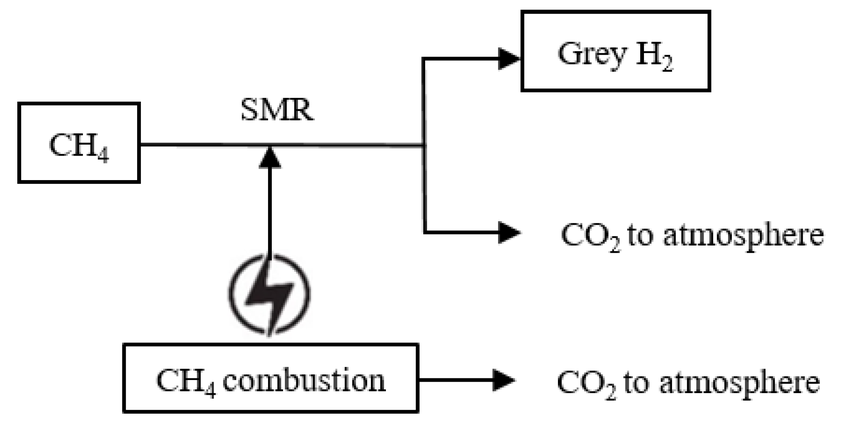GREY HYDROGEN : The Most Common and Most Controversial Form of Hydrogen

In the worldwide attempt to lower greenhouse gas
emissions, Hydrogen is attracting interest as a possible game-changer. Promoted
as a clean fuel that emits only water when burned, Hydrogen seems like the
perfect answer for decarbonizing hard-to-abate sectors like heavy industry,
aviation, and long-distance transport. However, the actual environmental benefits
of Hydrogen depend entirely on its production method. Among the various types
of hydrogen being produced, Grey Hydrogen is the most often produced and used
worldwide.
How Grey Hydrogen is produced?
Grey hydrogen is made from fossil fuels, primarily
natural gas, using a process called steam methane reforming (SMR). In this process,
methane (CH₄) reacts with high-temperature steam under pressure, producing Hydrogen
(H₂) and carbon monoxide (CO). This carbon monoxide is then reacted with water
(H₂O) to produce additional Hydrogen and carbon dioxide (CO₂). While the Hydrogen
is captured and used in industry, the CO₂ byproduct is released directly into
the atmosphere. This production method emits large volumes of greenhouse gases
and yet currently accounts for over 90 percent of Global Hydrogen production.
Source:Research Gate
Cost and its Impact on Environment
The wide appeal of Grey Hydrogen lies in its cost and
scale. The technology behind SMR is mature, and the infrastructure already
exists in many parts of the world. It is less expensive than producing Hydrogen
using renewable electricity, and so far, no alternative method has yet matched
it in terms of affordability and industrial readiness. Grey Hydrogen is
indispensable to industries such as oil refining, ammonia and fertilizer
production, methanol synthesis, and various chemical. Without it, many
essential products—from fuel to food—would become significantly more expensive
or difficult to manufacture.
However, there is a significant environmental cost
associated with this cost-effectiveness. For every kilogram of Grey Hydrogen that
is produced via SMR, between 9 and 12 kilograms of carbon dioxide is released.
This indicates that although Hydrogen itself is clean when used, its production
is not environment friendly. It not only contributes to global CO₂ emissions
but also relies on a fossil fuel for its production which is natural gas and that
has its own environmental and geopolitical ramifications. Methane leaks during
natural gas extraction and transportation further compound the climate impact,
as methane is a far more potent greenhouse gas than carbon dioxide over the
short term.
Grey Hydrogen is therefore a bit of a paradox. On the one
hand, it facilitates vital industrial operations and supports decarbonizing
energy systems. On the other, it significantly worsens the very problem Hydrogen
is supposed to help solve: climate change. Grey Hydrogen is still the most
affordable and scalable option available, which is why it continues to dominate
the industry despite its environmental drawbacks. Some policymakers and experts
argue that it can serve as a transition technology, buying time for cleaner Hydrogen
alternatives to become cost-competitive. However, others worry that continued
reliance on Grey Hydrogen delays vital actions at a time when the climate
crisis necessitates immediate change.
What is India Doing?
India is actively working to reduce the environmental impact of
Grey Hydrogen through several government-led initiatives aimed at promoting
Green Hydrogen. The flagship National Green Hydrogen Mission, launched
in 2023, targets the production of 5 million metric tonnes of Green Hydrogen
annually by 2030, supported by ₹19,744 crore in funding. The government has
also introduced the Green Hydrogen Standard, defining strict emission
thresholds for certified Green Hydrogen. Under the SIGHT (Strategic
Interventions for Green Hydrogen Transition) program, incentives are
provided for Green Hydrogen production and domestic electrolyzer manufacturing.
In a world striving for net-zero emissions, Grey Hydrogen
is unlikely to survive in the long run. However, it continues to play a key
role in the Hydrogen economy in the near future. Managing this reality and
using Grey Hydrogen in a practical way without compromising climate goals is
the problem. This might mean mandating carbon capture for existing plants, taxing
emissions to make clean Hydrogen more competitive, or accelerating research and
development into Green Hydrogen technologies.
Written By: PuspaKumari, Research Assistant, The Energy Forum.